As we were enjoying the yogurt, fruit, and steel-cut oats Marc had prepared for breakfast, Mattias looked at his phone and let out a whoop—his first exam wasn’t scheduled until 11:00, so he had a few more hours to study before he had to leave for school. We have been quite impressed with Mattias. In many ways he is a typical teenager, preferring to dress in all black and do his homework to the beat of the music pounding through his earbuds, and he was delighted when the fashionable black “murse” (aka “man purse”) he had ordered arrived this week. (“Now I won’t keep losing my keys,” he explained.) But in other ways, Mattias is not at all like other almost-fifteen-year-olds we have known. He is polite, pleasant, and willing to help around the house without complaint. He graciously slept on an inflatable mattress in Emery’s study so we could take over his room for a few nights. But what impresses us most is that he seems to enjoy participating in the general conversation, openly sharing his thoughts rather than responding to questions with monosyllables. Mattias and his dad enjoy hiking, biking, mountain climbing, and other outdoor adventures together, and he and Emery seem to have developed a healthy and happy stepson/stepmother relationship.

Amsterdam commuter train
But now it was time to say goodbye. Marc and Emery drove us to the same Almere transit station from which we had traveled into the city yesterday. Thanks to Emery’s good training, we knew exactly how to use the kiosk to buy our tickets. This time we were lugging all of our baggage, so we took the elevator instead of the stairs up to the tracks. When the doors opened, however, we discovered a couple of repairmen in the process of taking the turnstile apart. “You can’t go through here,” they told us. “You’ll have to go back downstairs to validate your tickets and then go up the stairs.” We were grateful that the men allowed us to leave our luggage by the elevator while we went back downstairs, went through the working turnstiles, and then climbed back up to track level to retrieve the bags and wait for the train to arrive.
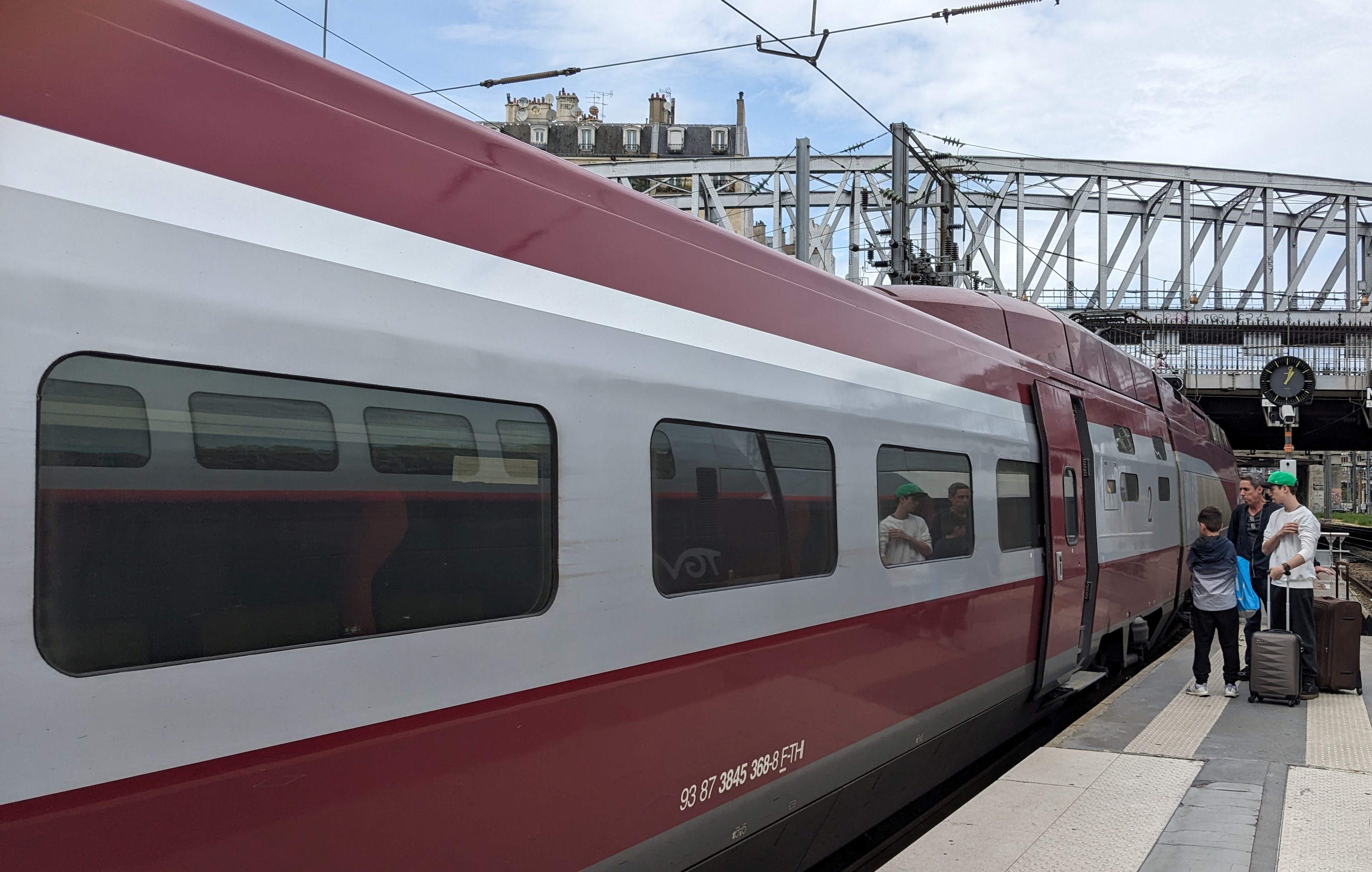
Thalys train
We arrived at the Amsterdam Centraal station well before the Thalys train from Amsterdam to Paris train was due to leave—which was a good thing because we could find no signage to indicate which track the high-speed train was running on. The official we asked for help very kindly showed us where to go and where to stand for our assigned car.
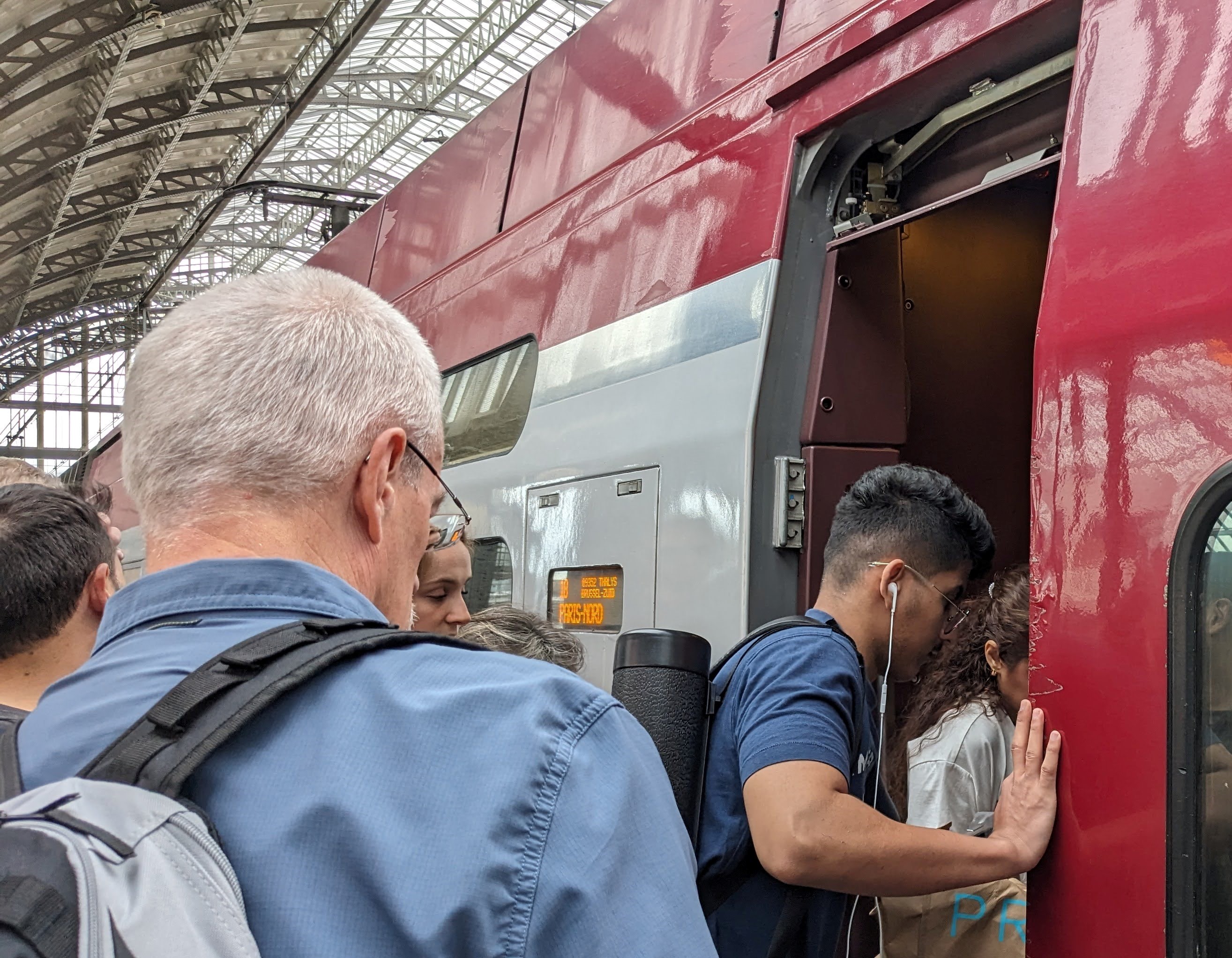
Crowd pressing to board the train
It wasn’t long before a whole throng of people joined us on the platform. When the train pulled into the station, we realized that most of them seemed to be trying to board the same car we were. Fortunately, we were among the first to get on, so we didn’t have to fight for room in the luggage rack and soon we had settled into our assigned seats. Within a few moments, however, a couple came up and informed us that we were sitting in the seats they had been assigned, and showed us their tickets to prove it. Alarmed, Michael double-checked our tickets, which appeared to be identical to those of the other couple. Since we had gotten there first, we said, “Sorry,” and stayed put. By this time, the car had filled up completely; not only was every seat taken, but the aisle was packed, too. One of the standers said to the people in front of us: “You’re sitting in our seats,” and then we heard the same claim coming from behind. Within a few moments, it became apparent that the whole car had been double-booked. Just then, the train began to move, and it appeared that the aisle-standers would have to remain so—at least until we stopped in Rotterdam.
A moment after we began moving, an announcement ostensibly explaining the situation came over the loudspeaker, but even though it was made in Dutch, French, and English, it had been spoken so quickly that no one could make out all the details. As passengers began to share snippets of the announcement each had been able to catch, we were able to piece the puzzle together: It turned out that the entire train comprised two separate trains, one numbered 9352 and the other 9452. The two had been joined in the middle, and both were being pulled by the same locomotive. Each train comprised eight cars numbered 1 through 8–which meant that there were two cars numbered 1, two cars numbered 2, and so forth. You had to look very carefully at your ticket to determine whether you were supposed to be on Train 9352 or 9452—a detail most travelers had overlooked. Passengers who had boarded the wrong train were instructed to get off at Rotterdam and switch. We were relieved to find that we were in the right seats on the right train, but felt sorry for the victims of such unnecessary confusion.
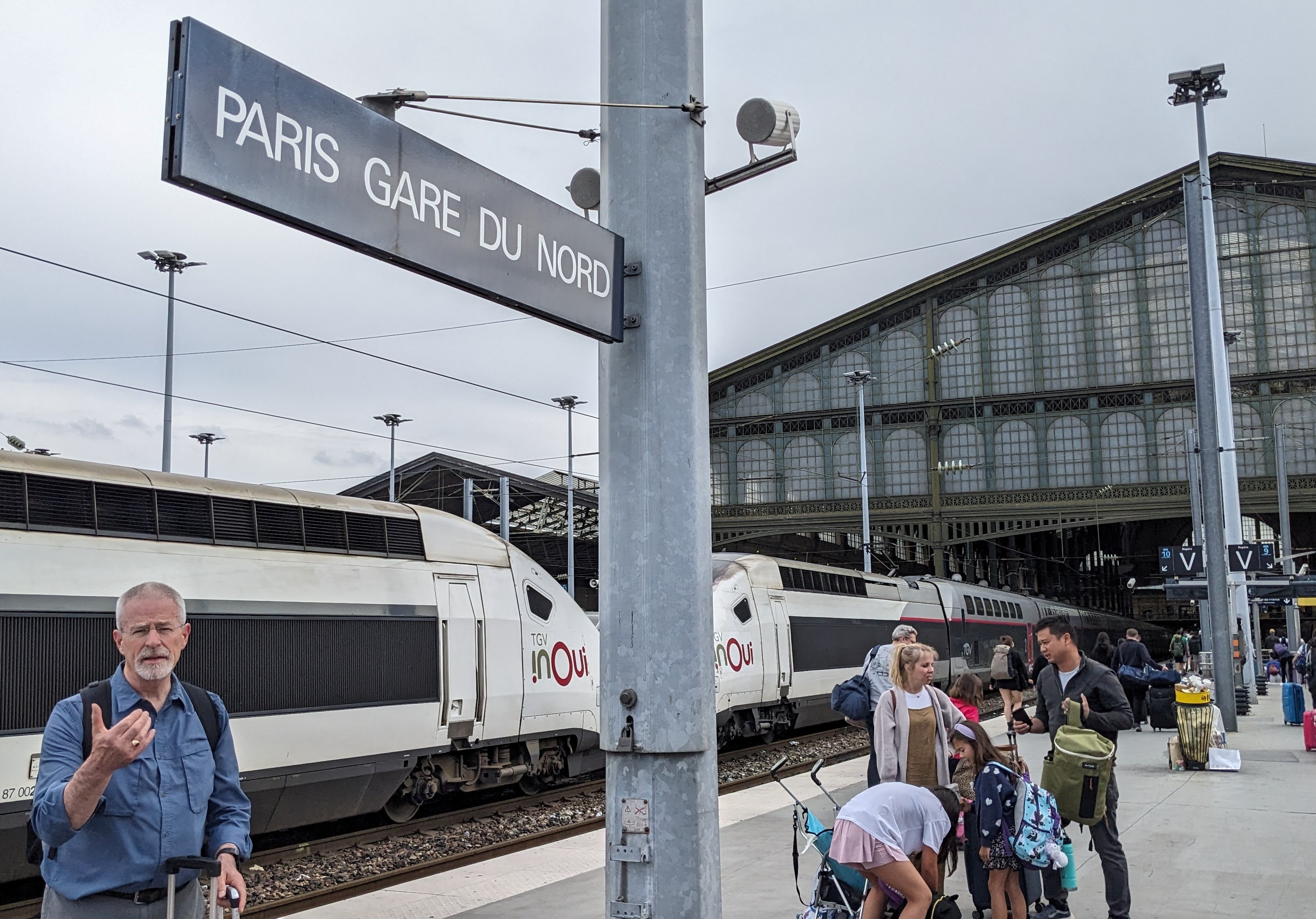
Arriving at Gare du Nord
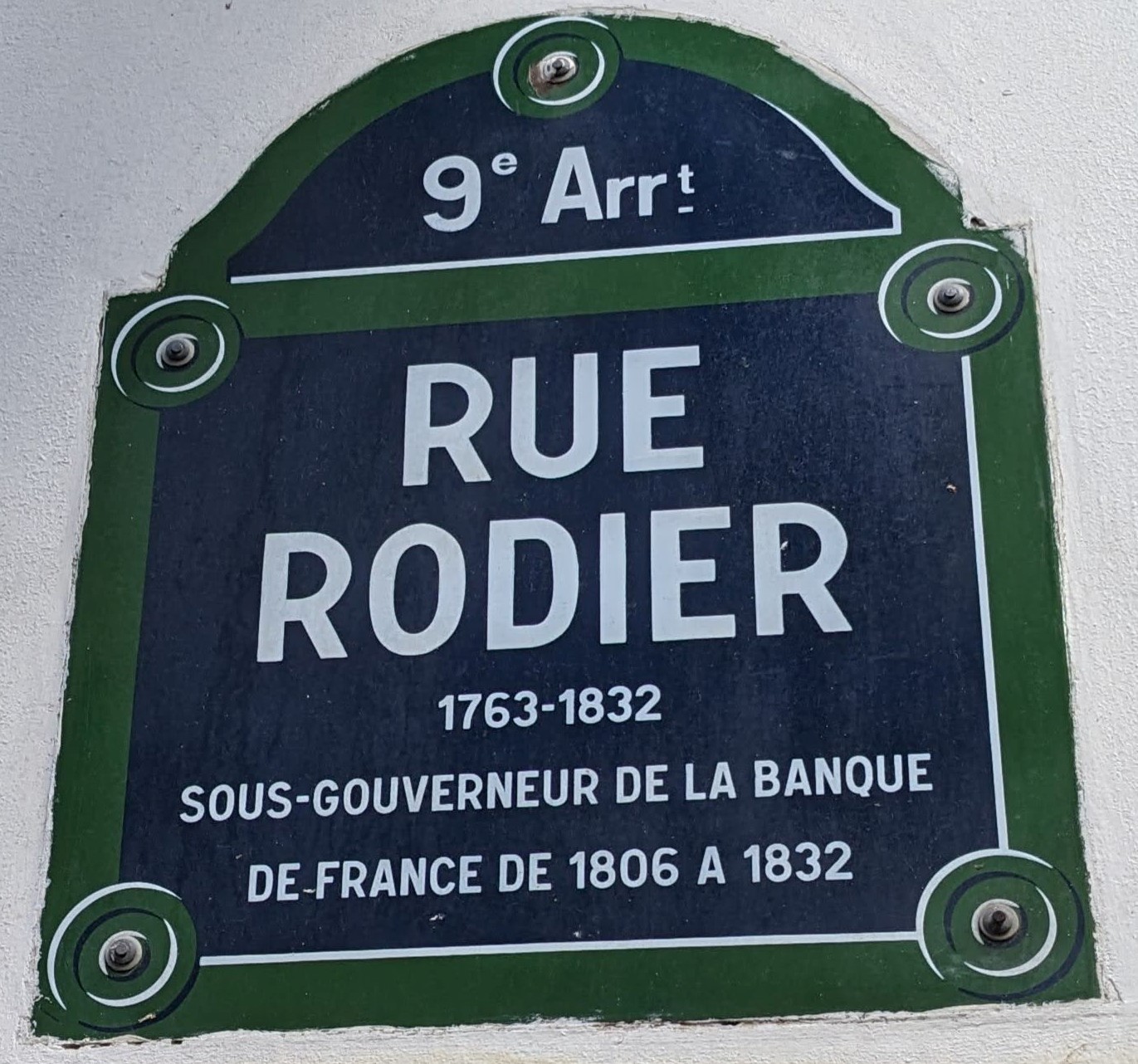
Our Airbnb was on this street in the 9th arrondissement
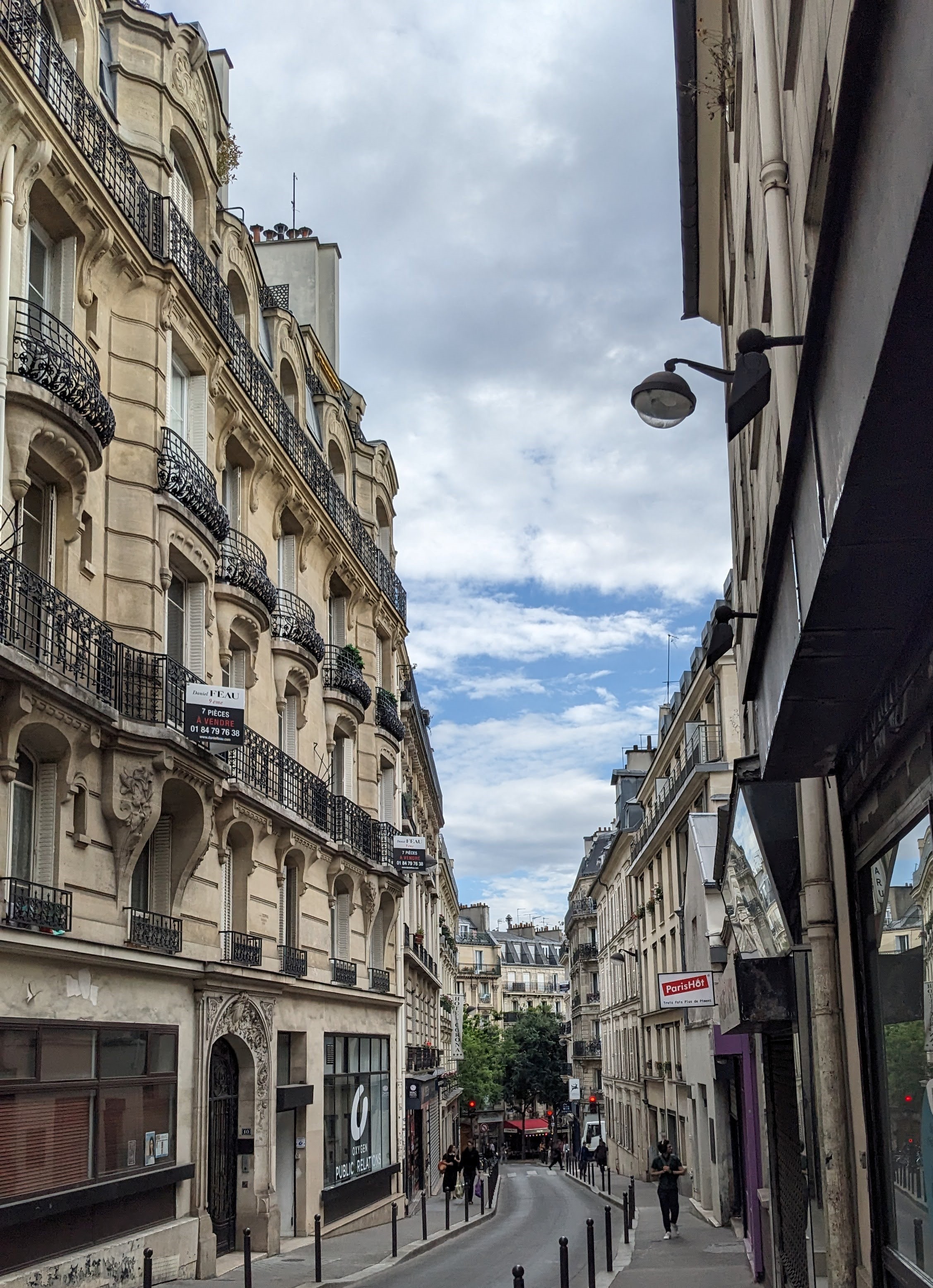
Rue Rodier was usually quiet
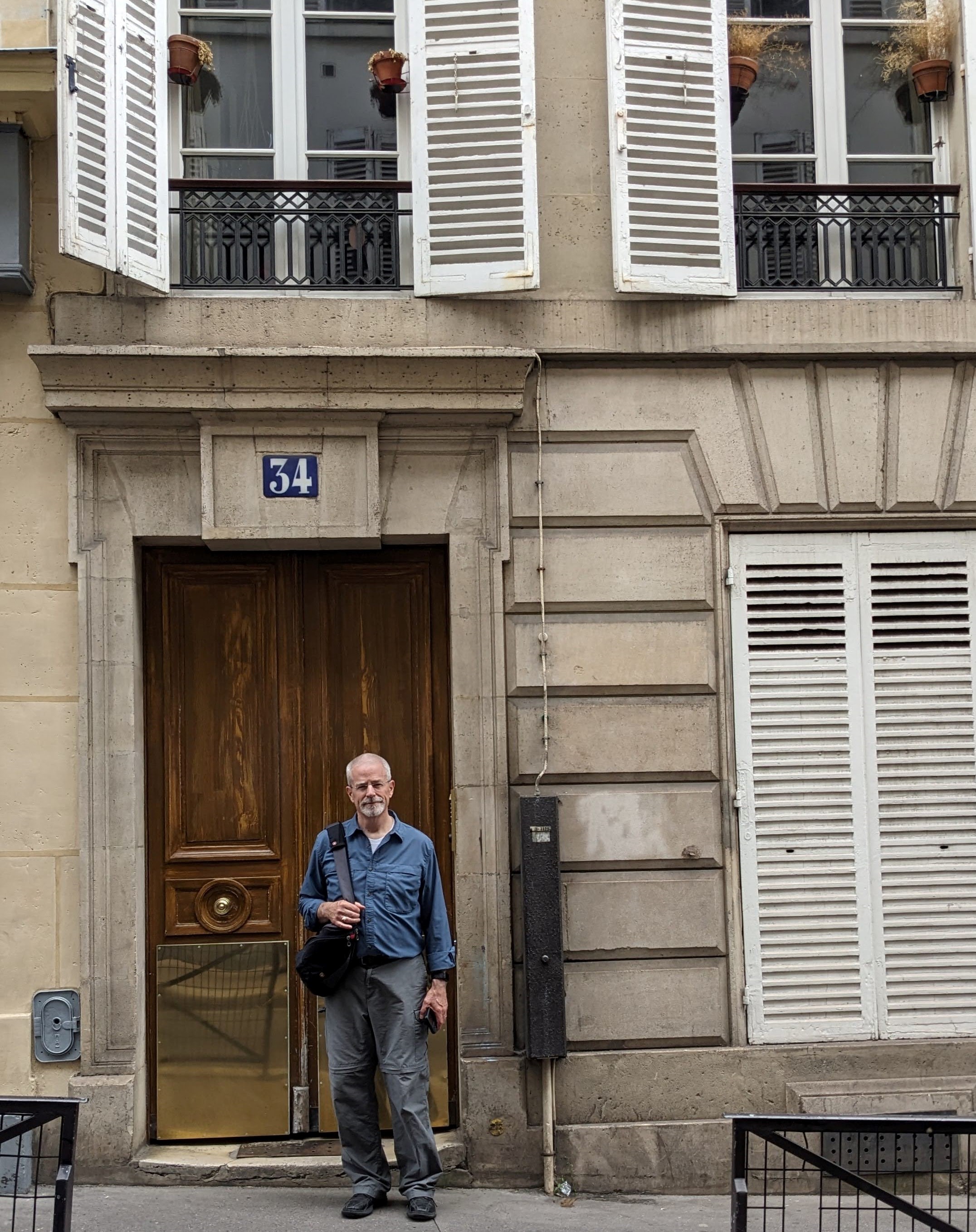
Michael outside our studio apartment
After that issue was sorted, the trip itself was uneventful and relatively short. Three and a half hours later we pulled into Gare du Nord, around 4:30 p.m. Nancy needed a toilet and was glad she had brought along a few €1 coins left over from our last trip to Europe because many public facilities still charge a fee.

Our small, neat, and comfortable “cocoon”
Pulling his suitcase with one hand and holding his smartphone map in the other, Michael led the way to our Airbnb on rue Rodier. The estimated twelve-minute walk stretched to about twenty, but we finally found the place on a quiet, secluded street. The Parisian studio apartment had been described as a “cocoon,” so although it was small, it was neat, comfortable, and completely satisfactory. How could it not be completely satisfactory? It was in Paris—and so were we! The last time we had been here (outside the airport, anyway) was in 1994, and it was great to be back.
After allowing ourselves about half an hour to unwind from our day of traveling, Michael phoned a highly rated restaurant within walking distance and made dinner reservations—relieved that his conversational French was still good enough to conduct such a transaction. Brasserie Paul et Julienne was on rue La Fayette, in a busier quarter of the Ninth arrondissement. Since it was threatening to rain, we asked the host to seat us at a table just inside, next to the open windows looking out on the street. It was a fabulous place to people-watch. How could it not be fabulous? It was in Paris—and so were we!
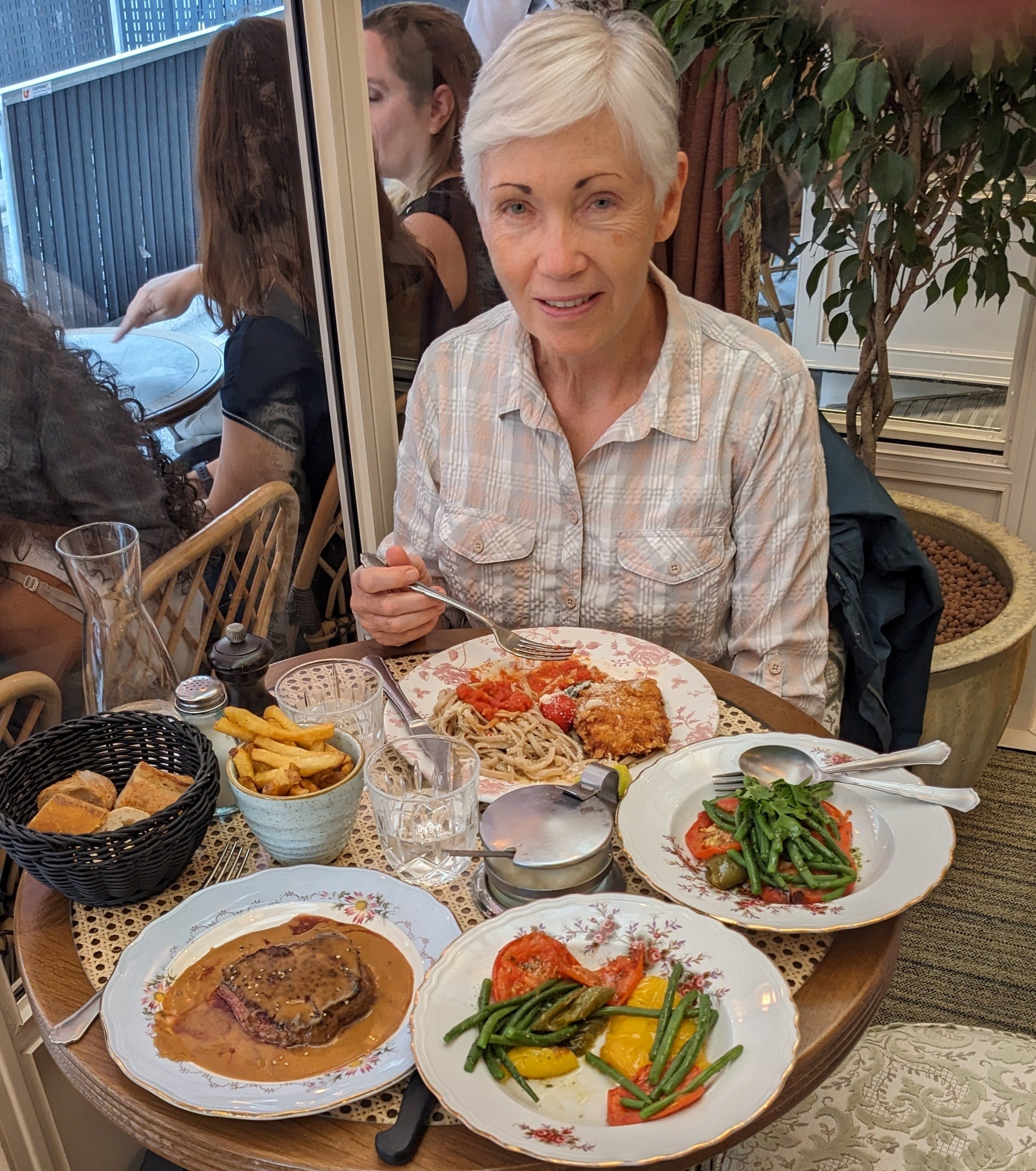
Michael’s beef steak and frites and Nancy with her veal cutlet
Michael ordered a beef steak with excellent frites and delicious haricots verts (green beans); Nancy had a veal cutlet with pasta and grilled vegetables.

Galeries Lafayette
When it came time for dessert, Michael ordered berries with a soft, sweet cheese. Nancy was curious about the item listed on the English menu as “spilled cream,” so she asked the waiter to please bring her a French menu to help her figure out what that mystery item actually was. In the original French, “spilled cream” was simply crème caramel. Why would Parisians think English speakers could not understand that? Nancy said it was the best crème caramel she had ever tasted, no matter what it was called. The whole meal was marvelous. And how could it not be marvelous? It was in Paris—and so were we!
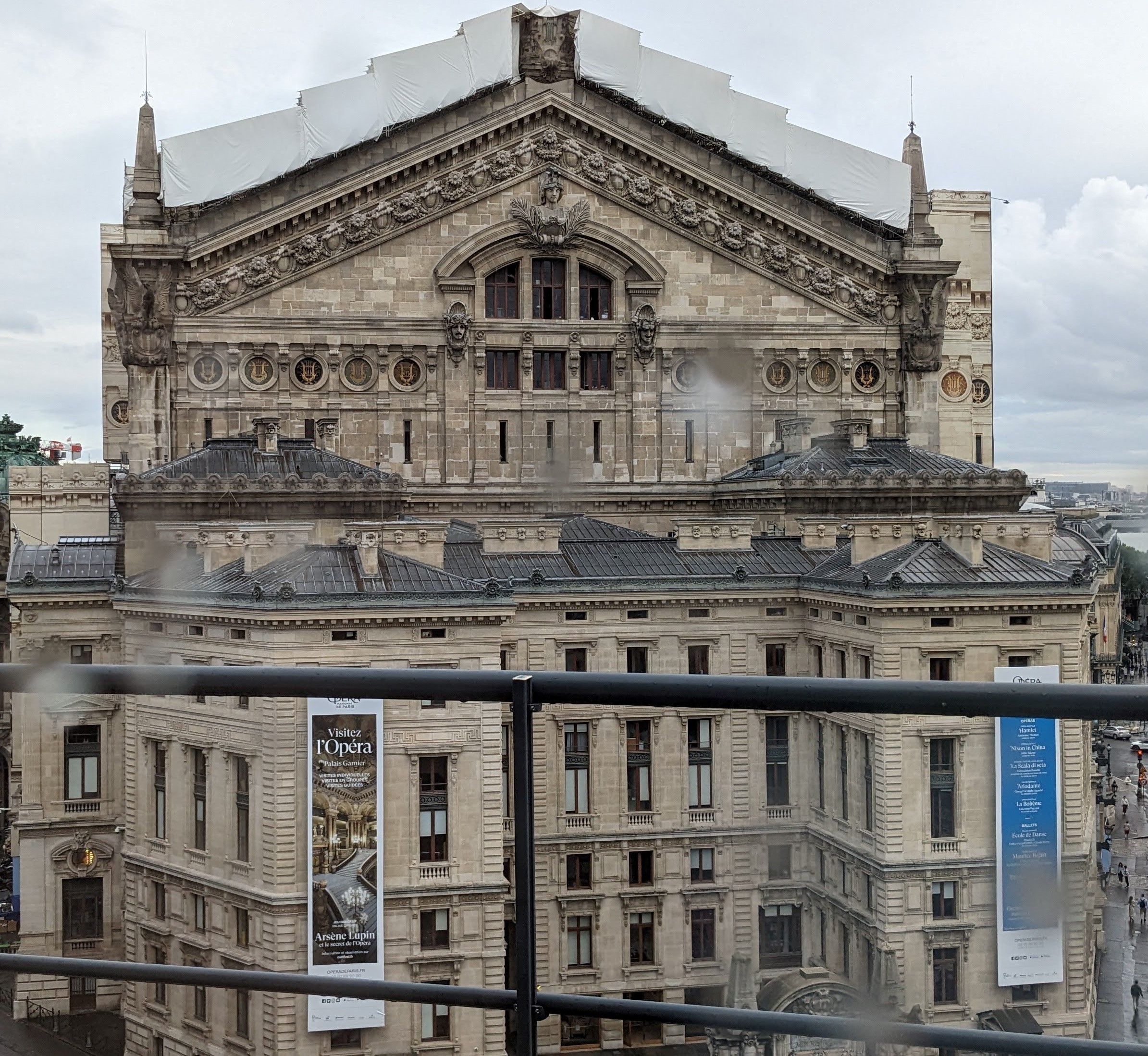
View of l’Opera from the sixth floor of Galeries Lafayette
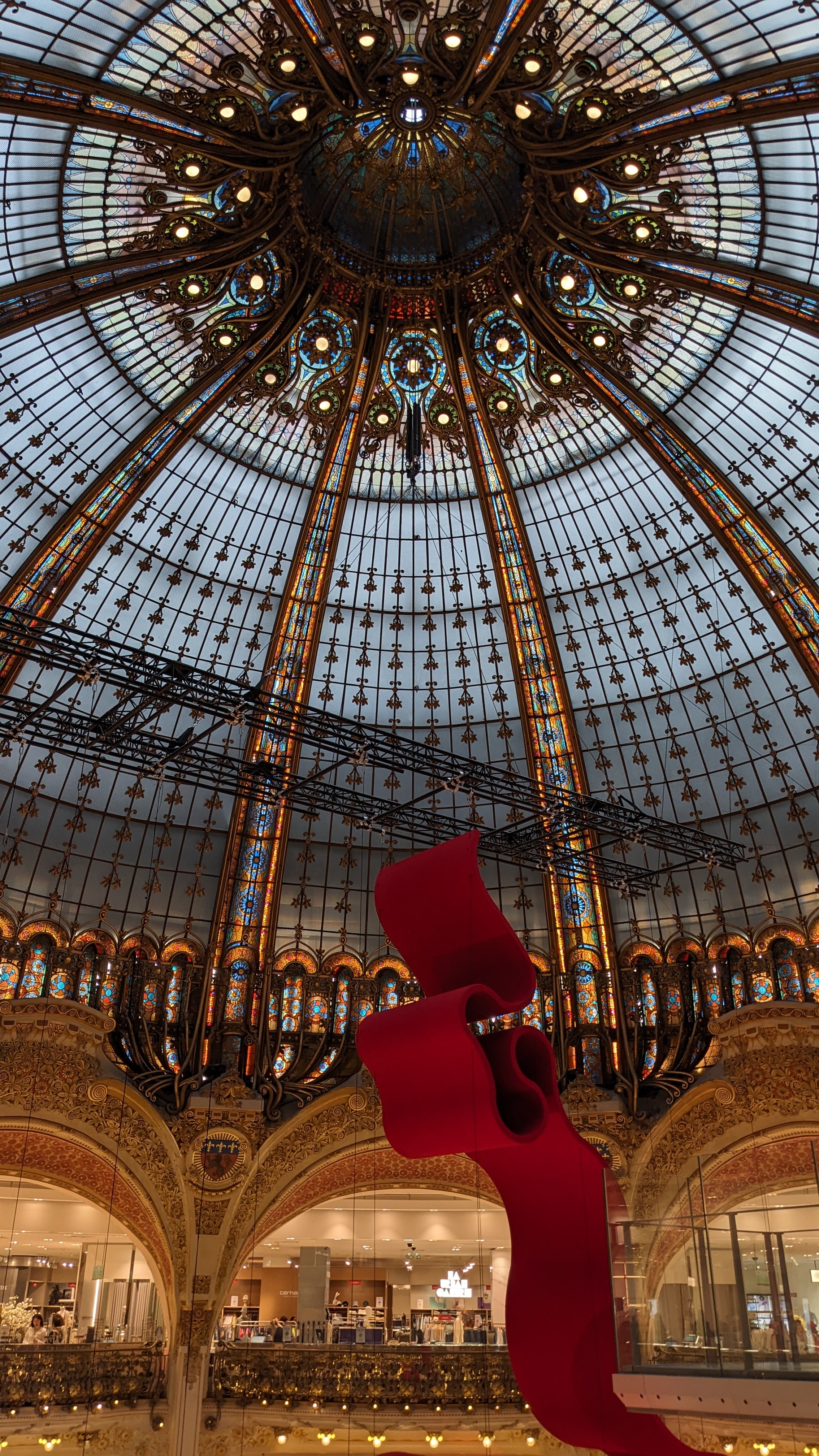
The seven-story interior dome at Galeries Lafayette

The sidewalk outside Printemps, a competitor to Galeries Lafayette; the name means “Springtime”
During dinner we noticed that Galeries Lafayette was just across the street, so as soon as we finished, we hurried over to the famous department store and rode the escalators up toward the seventh-floor observation deck. Alas, the escalator to the last level was roped off because the observation deck had already closed for the evening, but we still got a magnificent view of the opera house from the windows of the sixth-floor cafeteria. Maybe we’ll have a chance to go back for the seventh-floor’s full panorama another time.
The sun had not yet set, so we took a non-direct route as we walked back to our apartment, energized by the city. How could we not feel energized? This was Paris, and we were back! Only after we returned to the Airbnb and began seeing pictures of fireworks on Facebook did we remember that we were missing Fourth of July celebrations back in the U.S.
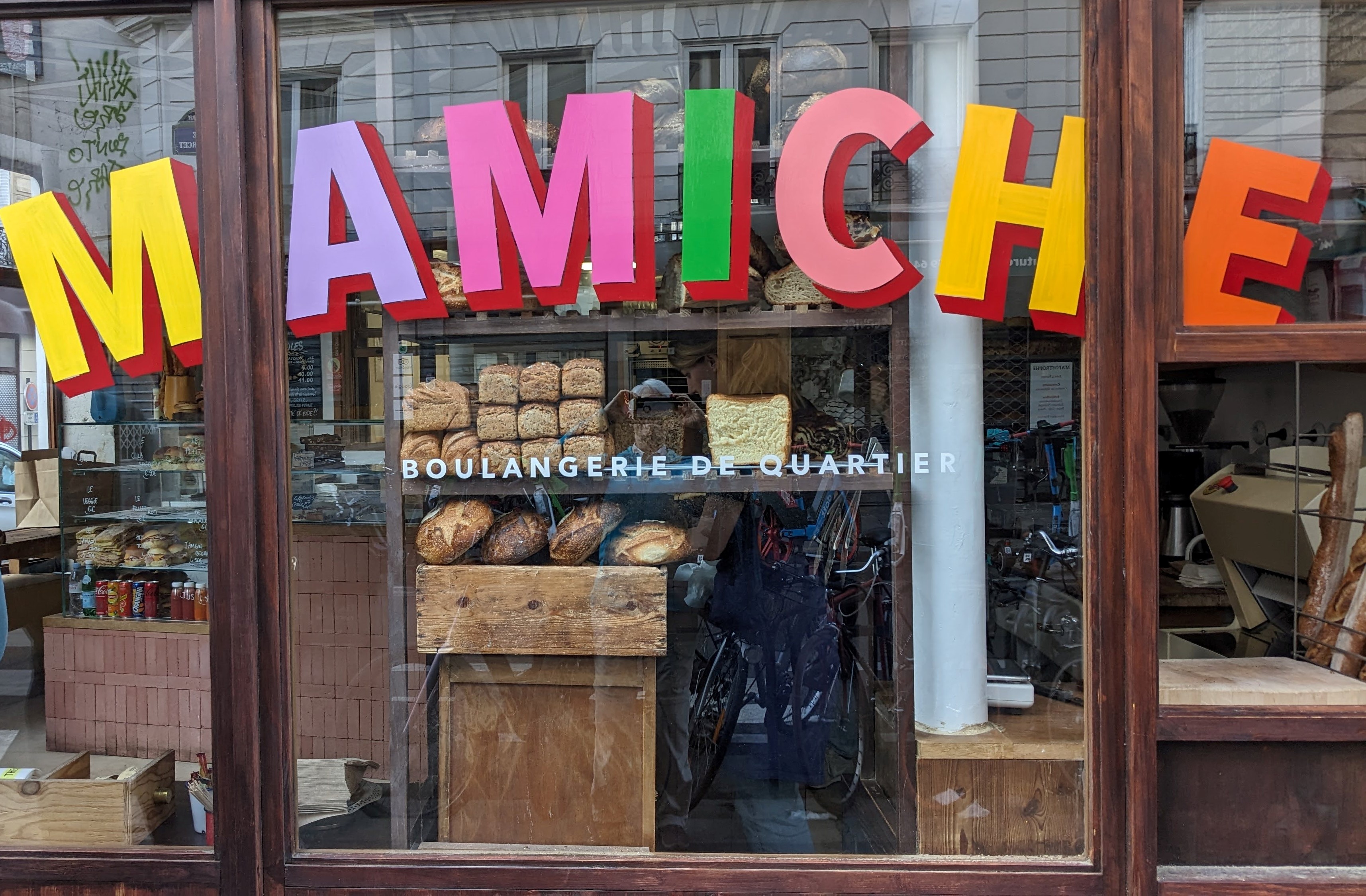
Boulangerie Mamiche

Many great breakfast options at Mamiche
The next morning, Michael had yogurt for breakfast again but what accompanied it was definitely Parisian: a croissant and a pain au chocolat from Mamiche, a boulangerie just down rue Rodier from our apartment. The orange juice served there was freshly squeezed and delicious. Nancy chose a brioche bun and a pain aux raisins to go with her mango-passion fruit smoothie.
The morning’s objective was to meet Michael’s sister Pat after her direct flight arrived from Salt Lake City. Because we would not be spending another night in Paris at this point in our trip, we had originally planned to haul our luggage from the Airbnb to Gare du Nord, and then to CDG on the RER (the Paris metro region’s high-speed train). We’d meet Pat at the airport after she got through customs, then haul three people’s luggage back to Gare du Nord on the RER and from thence across the city on the Metro to Gare Montparnasse, where we would board a train for La Rochelle. We began rethinking this transit plan when, a week or so before we left the States, local officials decided to close the Paris Metro at night after parts of the city erupted into rioting over the police shooting of an ethnic North African. Concerned for our safety, Phillip had cautioned us to avoid public transportation in Paris altogether, but because the unrest had subsided by the time we arrived, we chose to mostly ignore his warning. However, Michael wasn’t too keen on dragging luggage all over the city even during daylight hours, not only because a trio of semi-elderly American tourists might make too tempting a target for the unscrupulous and already riled-up, but also because our original RER/Metro transit plan sounded too unwieldy. So we decided to hire a limo to pick us up at the Airbnb, drive us to CDG to meet Pat, and then transport all of us to Gare Montparnasse. It was an expensive option, but undoubtedly the easiest—and, hopefully, the safest.
Michael started getting concerned again, however, when the limo failed to show up at the appointed time. Ten minutes went by. The driver phoned. “I’m running a little late, but I’m on my way.” Ten more minutes went by. He phoned again. “I’m almost there, but I’m stuck in traffic.” We believed him, because we had watched the narrow street in front of the Airbnb clog up as a delivery truck stopped a few doors down to unload dozens of bags of concrete mix. We worried that the limo would not be able to get past the obstruction, so when the driver called again, we arranged to meet him at a nearby intersection. Meanwhile, we pictured Pat wandering CDG’s vast network of confusing corridors, wondering where we were and worried that she wouldn’t be able to locate the right meeting place, but there was nothing to do but pray that we would find each other. Even though traffic was heavy all through the city, our driver nimbly navigated through it, impressing even Michael with his professional skills. When Michael finally got to the airport’s Arrivals Hall, he was relieved to discover that Pat had cleared customs only minutes earlier, leaving her no time to worry about missing her connection with us.
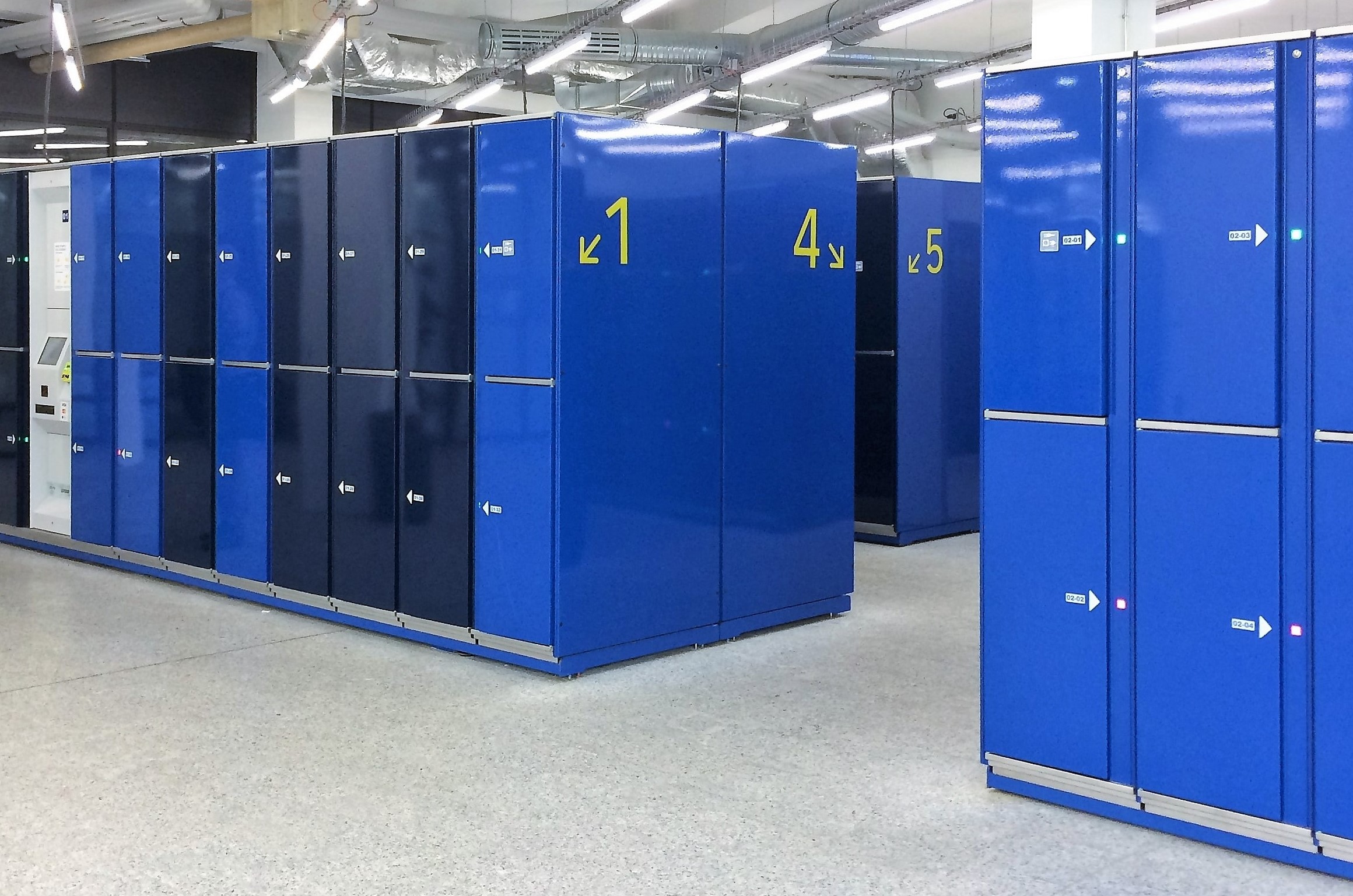
Lockers in Gare Montparnasse
The traffic we encountered as we drove to Gare Montparnasse was even worse than it had been earlier, but we could relax because it was now about noon and our train for La Rochelle was not scheduled to leave until 3:40 p.m. We wanted to go straight to the gare, however, because we needed somewhere to stash our bags while we got lunch and enjoyed Paris for a few more hours. Michael had remembered from his mission days that train stations had luggage lockers for short-term use, but his pre-departure online research did not turn up any such storage facilities except for third-party vendors that charged an arm and a leg. Now within Gare Montparnasse, he wasn’t sure exactly where to look for lockers, but eventually he spotted a sign that said Consign (literally, consignment) pointing toward a room full of large lockers—exactly what we needed.

Michael trying to orient himself
With our luggage securely stowed we left the train station, intent on locating the nearby crêperie that Michael had identified as a good spot for lunch. When we came out of the station, however, Michael found himself completely disoriented—not a state he experiences very often. He recognized the name of the street, but was thrown off when Google Maps directed him to walk in the opposite direction from the one he would have chosen. This was quite disconcerting!
As a young missionary, Michael had been assigned to work in the French capital after he had been in the country already for eighteen months. During that time he had been to Paris twice for conferences, but on those occasions had simply used the Metro to get where he needed to go— and usually had other missionaries to lead the way. He had never really had to navigate the city’s medieval maze of streets on his own. But then, with his new assignment, he arrived at Gare Saint-Lazare in the northwest quadrant of Paris carrying a suitcase and a bicycle. No one was there to lead him to the LDS chapel near the Place de la République on the east side of the city. So, after stowing his bag in a locker at the gare, he mounted his bike and started pedaling, confident that his innate sense of direction would get him to his destination. Every now and then he stopped to look at the maps posted near each Metro station, and within half an hour, he had arrived at the church. (The missionaries’ apartment was upstairs.) Later, he went back to Gare Saint-Lazare by Metro to retrieve his suitcase.

Gallettes Bretonne and a bowl of ratatouille
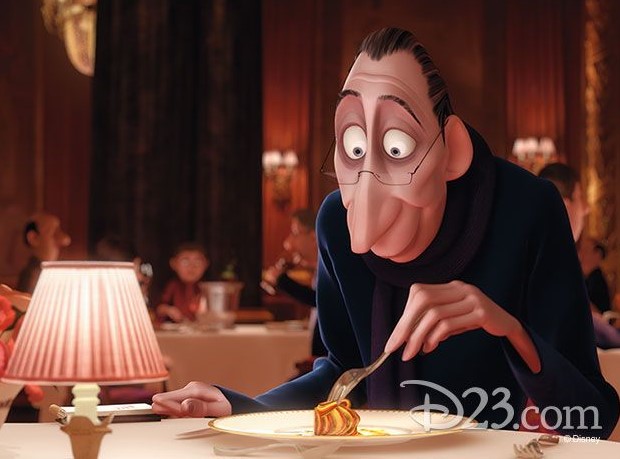
A bowl of ratatouille elicited a response from Nancy similar to that of food critic Anton Ego in the Disney movie: unmitigated delight
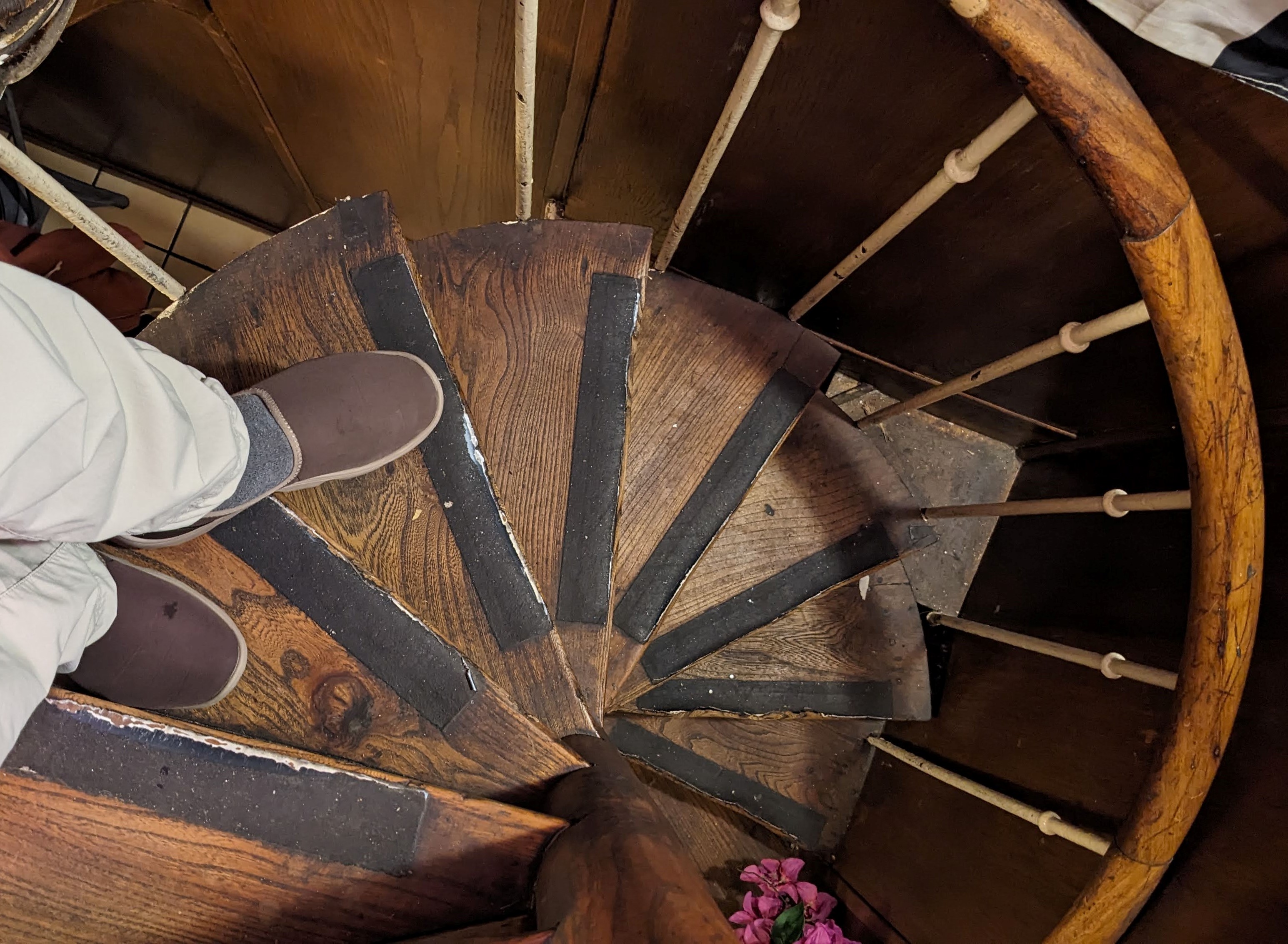
The toilets in small Parisian cafés are usually squeezed into an ancient cellar. The stairs leading to this one formed a particularly tight spiral
Certainly, Michael could find his way to a Paris restaurant now—especially if he didn’t have to get there on a bike. So, with smartphone in hand, he quickly reoriented himself and led Nancy and Pat to La Crêperie Bretonne on the rue du Montparnasse. Pat—still disoriented after her sleepless flight across the Atlantic—had a hard time deciding what to order. Although she had spent a few months in France as a college student, her command of the language had never been very strong, and the fog of jet lag made deciphering the menu even more difficult. She was not familiar with galettes Bretonnes, the savory, more filling buckwheat cousins of the sweet dessert crêpes she was used to, nor was she familiar with Emmenthal cheese (a type of Swiss), but she was pleased to become acquainted with both. Nancy liked the ham and cheese galettes, but was even happier with her side order of ratatouille.
While we were sitting at the café, Michael’s brother Phillip texted, saying that his daughter Astrid and nine-year-old granddaughter Sancie happened to be in Paris that day for medical appointments. “I think they will be on the same train to La Rochelle that you will be on,” he said. Michael texted Astrid and learned that she and Sancie not only had reserved seats on the same train, but also in the same car. What a delightful surprise!

A market we passed through on our return to the train station
We took our time walking back to the gare, soaking in as many sights, sounds, and smells of the city as we could before it was time to board the TGV (Train à Grande Vitesse) for La Rochelle. These high-speed trains have been hurtling across France for decades, regularly reaching speeds of 320 km per hour (about 200 mph). Our trip from Paris to the Atlantic coast of France—a distance of about 475 km (295 miles)—took just over three hours, or less than half of what it would have taken in a car. The only train in North America that can reach the same speed is Amtrak’s Acela, which runs up and down the Northeast Corridor, but because much of its track runs through densely populated areas, it can’t go very fast for very long. We wish the U.S. had high-speed rail lines across the Great Plains. And underground metro lines in all our big cities. We also wish all our cities had dedicated bike lanes. Paris has managed to establish them along most of its major thoroughfares since we were last here in the mid-1990s, though they are not as prevalent nor as well-used as they are in Amsterdam and Copenhagen. But, we thought, if Paris can make room for bike lanes, any city can!
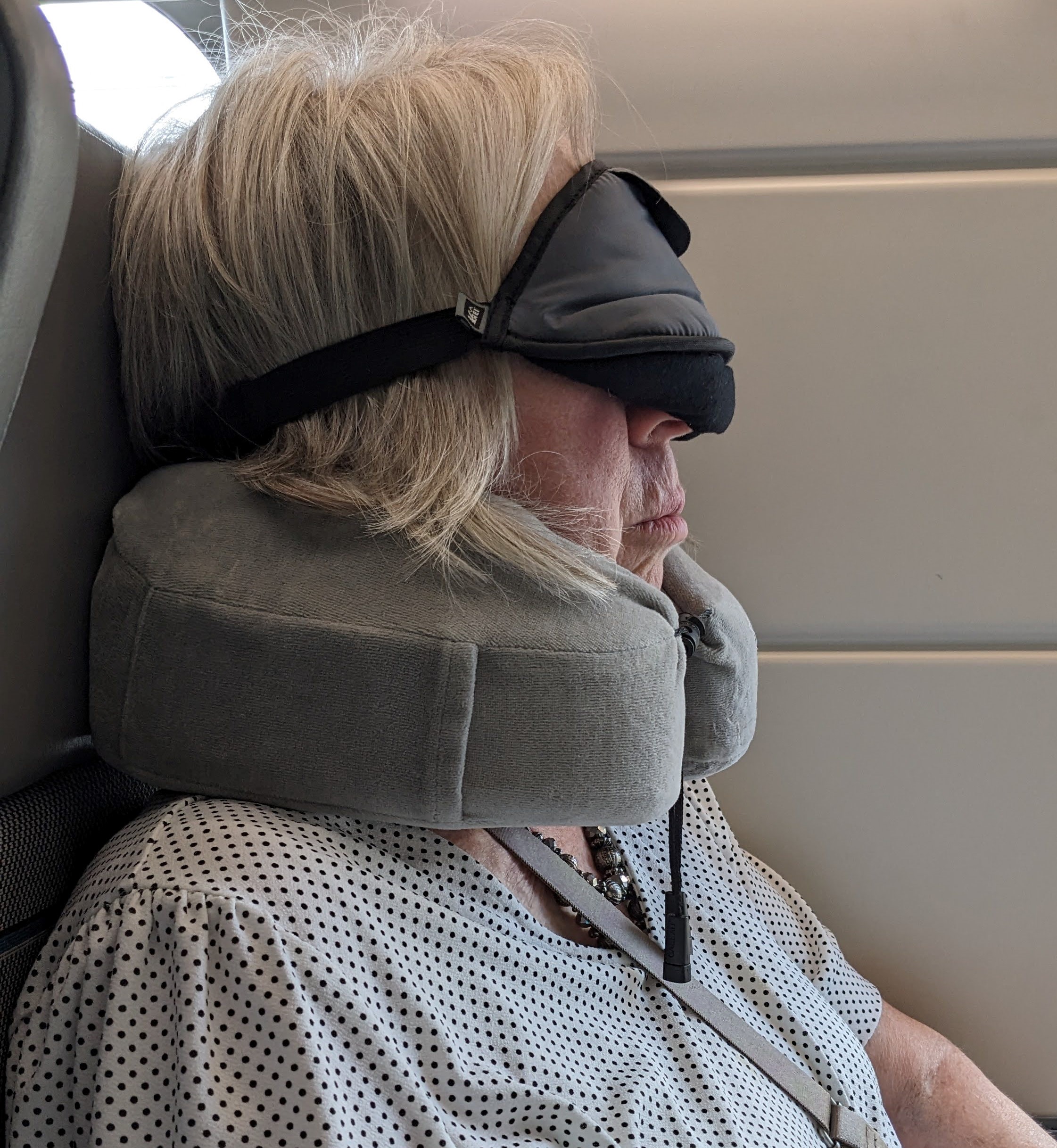
Pat made a valiant effort to sleep on the train
Pat made a valiant effort to sleep on the train but still did not succeed, so by the time we pulled into La Rochelle and saw Phillip waving to us from the platform, we had to practically pull her into an upright position and carry her off the train. Four-year-old Bertille, who had come with Phillip to meet us, eagerly embraced her mother and sister. Astrid offered to drive Pat home in her father’s car right away so Pat could lie down for a bit before dinner, so we waved goodbye to them and the girls and then walked with Phillip down the street to the car rental place, where a Citroën Crossfire C5 SUV was waiting for us.
Because Astrid and her children were already staying with Phillip and Patricia, there was no room in the house for three additional adults, so Phillip had found us a B&B about a kilometer away.

Our Citroën Crossfire C5 SUV

Our B&B was behind a storage lot for RVs and boats
With Michael at the wheel of the Citroën and Phillip navigating (intermittently, often as an afterthought between stories), we made it to Chez Cathy about 7:15 p.m. We were a little concerned about the neighborhood because across the street from the B&B were a couple of automobile repair yards, and the unpaved parking lot in front was full of boats and RVs. The place looked downright dumpy, and we were frankly surprised that Phillip and Patricia had chosen such accommodations for us. But our skepticism vanished once Cathy, the proprietor, led us into her modern, spacious home. As it turned out, Cathy was an old friend and painting-club associate of Patricia’s late mother, and thus was completely acceptable to Phillip and Patricia as our B&B hostess. Phillip explained that Cathy, a widow, rented out parking space on her property to supplement her income from the B&B—thus all the boats and RVs out front.
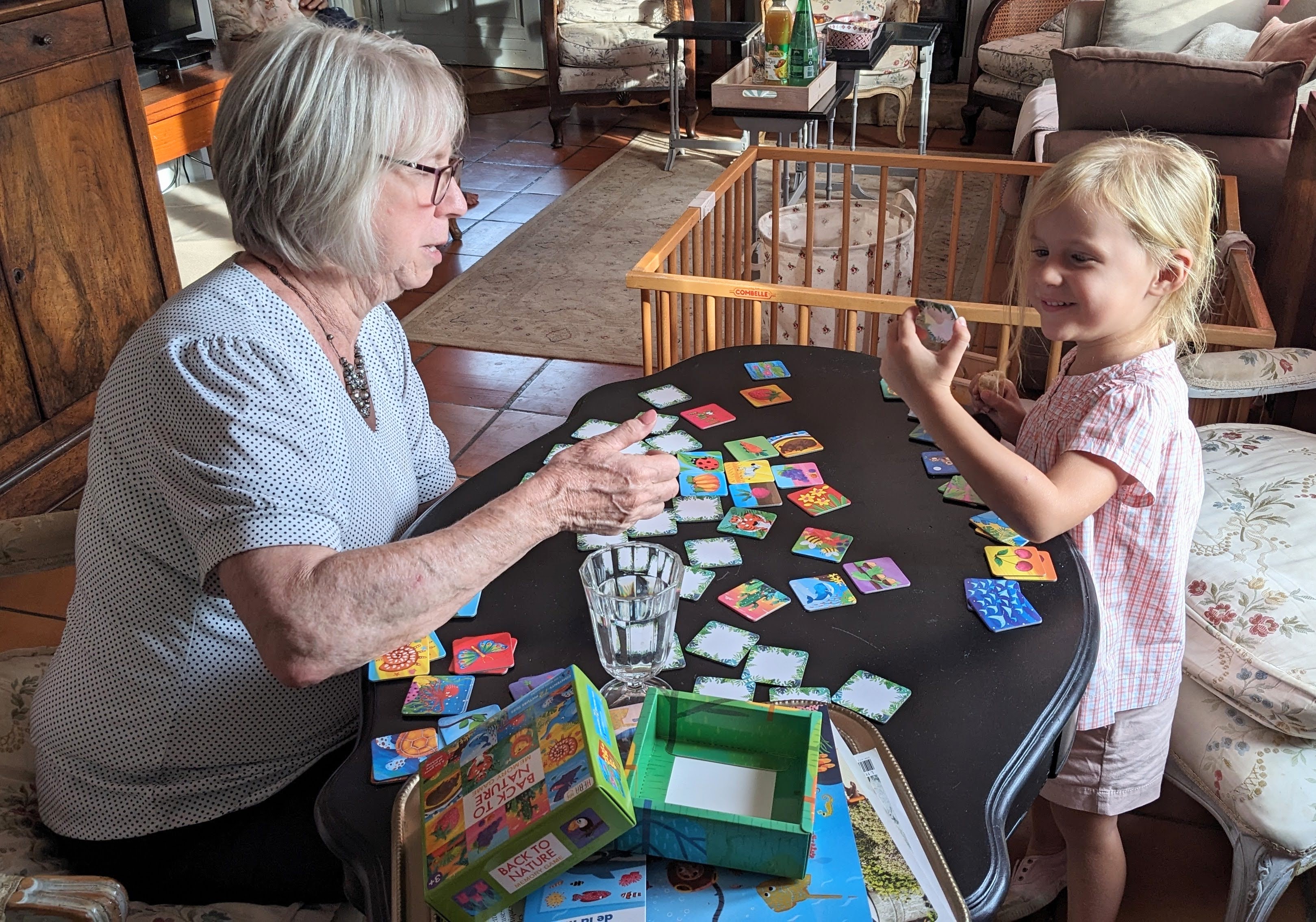
Pat playing Memory with Bertille
After being shown to our rooms and depositing our luggage, we headed over to the house on rue du Pertuis d’Antioche for dinner. When we arrived, we found that Pat had summoned enough energy to engage Bertille in the Memory game she had brought as a gift for the girls. Pat is never happier than when she can be involved with grandchildren–whether her own or someone else’s—but she was still so exhausted that she almost asked to be excused from dinner so she could just go to bed. She changed her mind, however, when she heard what was on the menu.

Hors d’oeuvres

Coquilles St. Jacques

Pat trying to stay awake during the cheese course

Patricia in her culinary domain with a pan of flaming scallops
Patricia had prepared hors d’oeuvres, of course: tiny pancakes (what New Zealanders would call “pikelets”) topped with a spread of pink fish roe; grape tomatoes from the garden; and chunks of a very good cantaloupe. We moved to the dining room for the main course: Coquilles St. Jacques—Pat’s all-time favorite—served in scallop shells the family had collected from the seashore over the years. This impressive and delicious dish was followed by salad and a selection of cheeses, and then by a crème caramel. It was an absolutely beautiful meal.
By the time we finished eating around 9:30 p.m, Pat could barely keep her eyes open, so we took her over to Chez Cathy and let her finally get into bed. The next morning she confessed that she had fallen asleep on top of the bed, still fully dressed.
Bravo!! What a wonderful adventure. This is the first one I’ve been able to open for some reason, so it was wonderful to catch up on your amazing adventures!!’
What a delightful trip (so far). It is always good to be in Paris, for however long. Of course, now we have to start planning to get there again soon! Thanks for sharing all of the food details with photos. We recently re- watched Ratatouille, a charming little movie, and so very Parisian.
Paris is, as they say in Sabrina, always a good idea.